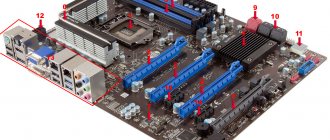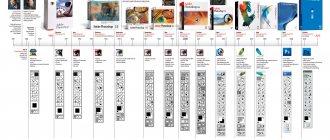Types of batteries
From the beginning of the era of development of mobile devices to the present day, various types of batteries have been used for autonomous operation:
- Nickel-cadmium power supplies are the oldest types of batteries used in early mobile devices. They are characterized by a large number of disadvantages: the presence of toxic substances in the composition, low capacity, high production costs, and rapid wear. In addition, before using such batteries, it was necessary to perform several charge/discharge cycles.
- Nickel metal hydride batteries are batteries that do not contain toxic cadmium and have a less pronounced memory effect. However, these elements were not without drawbacks: they required an expensive and difficult to manufacture charger, and were characterized by a reduced service life.
- Lithium-ion batteries are the batteries that have contributed the most to the development of the mobile device industry. The main advantage of the elements is a long battery life. Also, lithium-ion batteries do not have a disadvantage called the memory effect. Many modern portable devices (tablets, smartphones ) have a built-in lithium-ion battery.
- Despite the advantages described above, it is not without some disadvantages:
- Fails due to operation at low or very high temperatures (the permissible temperature range is quite narrow);
- High manufacturing costs;
- The need to maintain a charge (deep discharge damages the element);
- Relatively short period of operation (obsolete in 2-3 years).
- Lithium - polymer batteries, which are an improved version of the previous type. Instead of an electrolyte, a polymer mass is used. It is non-explosive and allows you to create batteries of almost any shape. The remaining characteristics of the devices remain the same.
Depending on the design features of the mobile device, all batteries can be divided into:
- Removable - those that the user can easily remove on his own by detaching the cover to open the battery compartment. As a rule, removable batteries are installed in budget smartphones. Non-removable - located inside the housing, which can only be disassembled by a qualified specialist with the appropriate equipment and tools. A good example is Apple products.
Inexpensive phones with a good camera and battery
How to find a device with a good, powerful battery among inexpensive smartphones. After researching the market, we selected the most worthy phones at an affordable price, with a good camera and a capacious battery. We present the best inexpensive phones with a powerful battery, push-button and full-screen. In the daytime, these devices show colors in all their glory; it is better to avoid night shooting with budget models.
The GoClever Quantum 2500 (Rugged) smartphone is equipped with a thin metal and fiberglass body. The battery power of 5000 mAh supports the operation of two built-in cameras for artistic photography of 13 and 5 megapixels. The device's weight of 255 grams was mainly due to the use of an outstanding battery. The phone costs 11,000 rubles.
One of the bestsellers is the BQ BQ-5202 Space Lite model. In daylight, the 13 MP camera takes good photos and videos. The powerful battery holds 4000 mAh of energy, but it will not be possible to remove the device without violating the warranty. The RAM of an inexpensive phone is 2 GB. This is due to the reduction in cost of the model. The market price of a screen phone is 9 thousand rubles.
The well-known brand does not need advertising, providing the ASUS ZenFone 3s Max ZC521T1 phone with excellent functionality. The device has a 5.2-inch screen for 2 SIM cards, a good 13-pixel camera, and a dual LED flash. Smart RAM 3 GB, battery capacity 5000 mAh. The downside is the lack of fast charging. The price of a phone with a capacious battery is around 10 thousand rubles.
Battery Features
Since lithium-ion and lithium-polymer batteries are the most common in our time, we will consider their characteristics.
Li-ion is a designation for lithium-ion batteries. The first batteries were introduced in the early 90s. They contain two electrodes: an anode on copper foil and a cathode on aluminum. Between them there is an electrolyte (liquid or in the form of a gel). The current carriers in such batteries are positively charged lithium ions.
The first batteries used a lithium metal anode, which, when it came into contact with certain other substances contained in the battery, contributed to the release of gas. For this reason, the batteries “swelled”.
Some budget smartphones still have this problem. Therefore, it is recommended to use only chargers suitable for current parameters; After a large number of charge/discharge cycles, replace the battery.
In order to increase the operating safety of lithium-ion batteries, microcontrollers are built into them. They perform the following functions:
Why is my phone battery not charging?
There is only one reason why batteries cannot be charged without external damage and distorted shapes of the case with a lithium galvanic cell - your charger does not have enough current.
The outgoing current of your adapter is not a constant value, but the maximum permissible (nominal) for normal operation of the power supply. Calculated using the formula I = U/R, where:
- I – current strength, A (ampere);
- U – voltage V (volts);
- R – resistance, Ohm.
Note. It must be said that the current that passes through your battery is a total value and may exceed the rated value or be less due to the fact that you use your phone while charging
Let’s say the power supply “doesn’t want to charge” your phone’s battery. It has an output current of 1.2 A and a voltage of 5 V. The product of current and voltage is the power (P) of the power supply. It is measured in watts (W) and is calculated as follows:
- P = I*U;
- Р= 1.2*5 =6 W.
Standard telephone batteries are produced with a voltage of 3.7 V. If your battery does not start the phone, then its voltage is about 3 V. It can also be completely “dead” - 0 V.
In order for a 6 W power supply to start charging a battery with a residual voltage of 3.7 V, it needs a current of 1.62 A. This indicator can only be achieved by increasing the voltage or reducing the resistance in the power source.
When replacement is required
The main characteristic of a battery is its capacity. It characterizes the amount of current that a battery can accumulate during a full charge to ensure autonomous operation of a portable device. The parameter is measured in the following units - mAh (milliamp-hour). Modern smartphones have batteries with a capacity of 2000-6000 mAh.
Over time, the battery capacity decreases due to chemical processes occurring inside. The lower the actual capacity in relation to the parameter declared by the manufacturer, the faster the element needs to be replaced.
The main signs of a sharp decrease in capacity:
- Strong heating under minor loads;
- Sudden shutdown, even if the indicator did not show a full discharge;
- Battery swelling;
- Discharge too fast.
Ways to restore your phone battery
There are 2 ways to restore your phone battery:
- unprofessional;
- professional.
Unprofessional way to restore battery
In the previous section of this article, we came to the conclusion that in order to charge a dead battery, we need a power source with a higher amperage. A power supply with a constant output voltage of slightly higher power (current, of course) than your power supply is suitable here. But make sure that the voltage is not too high. Power supplies with a voltage of 6-12 V may be suitable.
Helpful advice! A new 9 V battery, approximately 2-2.5 times larger in volume, is ideal. It is not very expensive and can be used in other household appliances. You can use 6 batteries of 1.5 V each, connected in series.
After you find a suitable power source, you need to come up with a device that will help you connect the contacts of the source to the contacts of the battery for a short time. The design of such devices will depend only on the shape and location of the contacts.
You can do it as shown in this video:
Do not abuse charging time. The higher the source voltage, the less time it should take to recharge your battery. On average, a few minutes are enough for the battery to charge to 3.7 V. If you put it in the phone and it does not start from it, then the charging time needs to be increased and charge the battery until it turns on the phone. After the phone turns on, connect your charger to it and charge the battery as usual until it is fully charged.
The professional way to restore your battery
This method is associated with the cost of purchasing a laboratory power supply (LBP). It is shown in the picture below.
However, its design is not complicated, and a radio amateur can assemble it himself.
How LBP works is shown in this video:
Its main feature is the presence of a rheostat - a device that allows you to regulate the resistance of the current in the circuit, and therefore its strength and voltage.
To charge the phone battery, you need to use paper clip pliers to bend the two gripping contacts and attach them to the battery with rubber bands. Then you need to turn on the power supply and set the voltage on it to 0 V. We connect the clamps from the power supply wires to these improvised contacts: plus to plus, minus to minus. We gradually increase the voltage.
The moment you start increasing the voltage, numbers will appear on the ammeter display. This is the current the battery draws to charge. Over time, it will fall, and the voltage indicator will increase.
Helpful advice! To charge the battery evenly and correctly, it is necessary to take into account the amount of electrical charge that passes through its conductor in 1 hour. This value is indicated on the battery case and is measured in milliamp-hours (mAh).
You should not increase the charge level of your battery until a zero reading appears on the LBP ammeter at the maximum voltage reading. The maximum voltage when charging any telephone battery does not exceed 7-7.5 V.
How to extend the service life
To avoid rapid battery failure, you need to follow these simple rules:
- Do not charge fully every time. 90-95% is quite enough.
- Avoid complete discharge, in which the device turns off on its own.
- Use energy saving mode if available.
- Calibrate the controller - do a full discharge/charge cycle at least once a month.
New smartphones install additional power/charge controllers on the circuit. If they do not work correctly, signs may appear indicating a battery failure. The best option is to contact a service center. Only experienced specialists will be able to determine the true cause of rapid discharge or sudden shutdown of the device.











